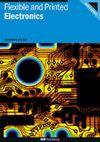All inkjet-printed organic solar cells on 3D objects
IF 3.2
4区 工程技术
Q3 MATERIALS SCIENCE, MULTIDISCIPLINARY
引用次数: 0
Abstract
Drop-on-demand inkjet printing is a promising and commercially relevant technology for producing organic electronic devices of arbitrary shape on a wide variety of different substrates. In this work we transfer the inkjet printing process of organic photovoltaic devices from 2D to 3D substrates, using a 5-axis robot system equipped with a multi-nozzle inkjet printing unit. We present a ready-to-use 3D printing system for industrial application, using a 5-axis motion system controlled by commercial 3D motion software, combined with a commonly used multi-nozzle inkjet print head controlled by the corresponding printing software. The very first time inkjet-printed solar cells on glass/ITO with power conversion efficiencies (PCEs) of up to 7% are realized on a 3D object with surfaces tilted by angles of up to 60° against the horizontal direction. Undesired ink flow during deposition of the inkjet-printed layers was avoided by proper ink formulation. In order to be able to print organic (opto-)electronic devices also on substrates without sputtered indium tin oxide bottom electrode, the bottom electrode was inkjet-printed from silver nanoparticle (AgNP) ink, resulting in the first all inkjet-printed (i.e. including bottom electrode) solar cell on a 3D object ever with a record PCE of 2.5%. This work paves the way for functionalizing even complex objects, such as cars, mobile phones, or ‘Internet of Things’ applications with inkjet-printed (opto-)electronic devices.三维物体上的所有喷墨打印有机太阳能电池
按需喷墨打印是一种前景广阔的商业相关技术,可在各种不同的基底上生产任意形状的有机电子器件。在这项工作中,我们利用配备多喷嘴喷墨打印装置的五轴机器人系统,将有机光伏器件的喷墨打印工艺从二维基底转移到三维基底。我们为工业应用展示了一种即用型三维打印系统,它使用由商用三维运动软件控制的五轴运动系统,结合由相应打印软件控制的常用多喷嘴喷墨打印头。首次在玻璃/ITO 上实现了喷墨打印太阳能电池,其功率转换效率 (PCE) 高达 7%。在喷墨打印层的沉积过程中,通过适当的墨水配方避免了意外的墨水流动。为了在没有溅射铟锡氧化物底电极的基底上也能打印有机(光)电子器件,使用纳米银(AgNP)墨水对底电极进行了喷墨打印,从而首次在三维物体上实现了全喷墨打印(即包括底电极)太阳能电池,其 PCE 达到创纪录的 2.5%。这项工作为汽车、手机或 "物联网 "应用等复杂物体的喷墨打印(光)电子器件功能化铺平了道路。
本文章由计算机程序翻译,如有差异,请以英文原文为准。
求助全文
约1分钟内获得全文
求助全文
来源期刊

Flexible and Printed Electronics
MATERIALS SCIENCE, MULTIDISCIPLINARY-
CiteScore
4.80
自引率
9.70%
发文量
101
期刊介绍:
Flexible and Printed Electronics is a multidisciplinary journal publishing cutting edge research articles on electronics that can be either flexible, plastic, stretchable, conformable or printed. Research related to electronic materials, manufacturing techniques, components or systems which meets any one (or more) of the above criteria is suitable for publication in the journal. Subjects included in the journal range from flexible materials and printing techniques, design or modelling of electrical systems and components, advanced fabrication methods and bioelectronics, to the properties of devices and end user applications.
 求助内容:
求助内容: 应助结果提醒方式:
应助结果提醒方式:


